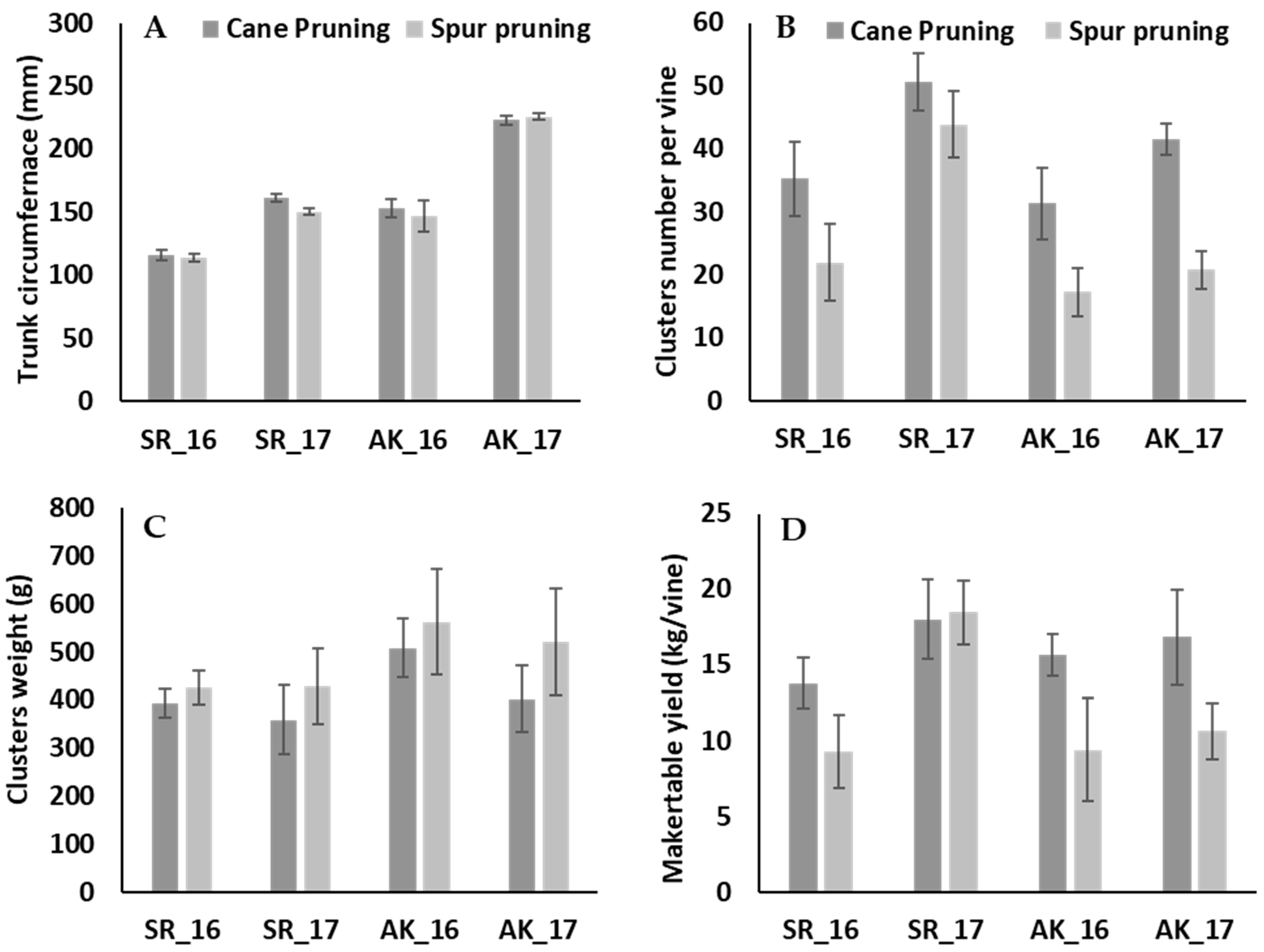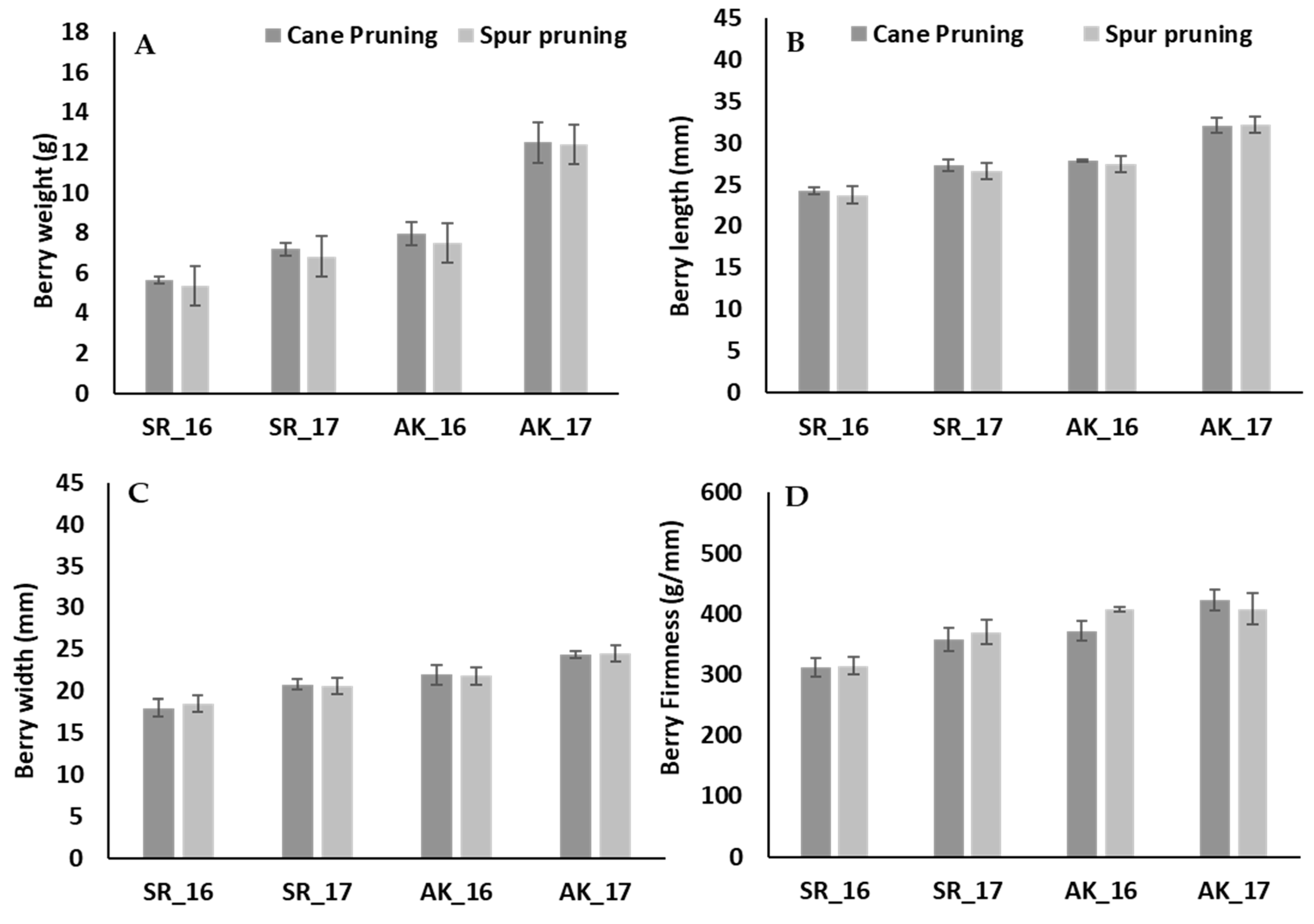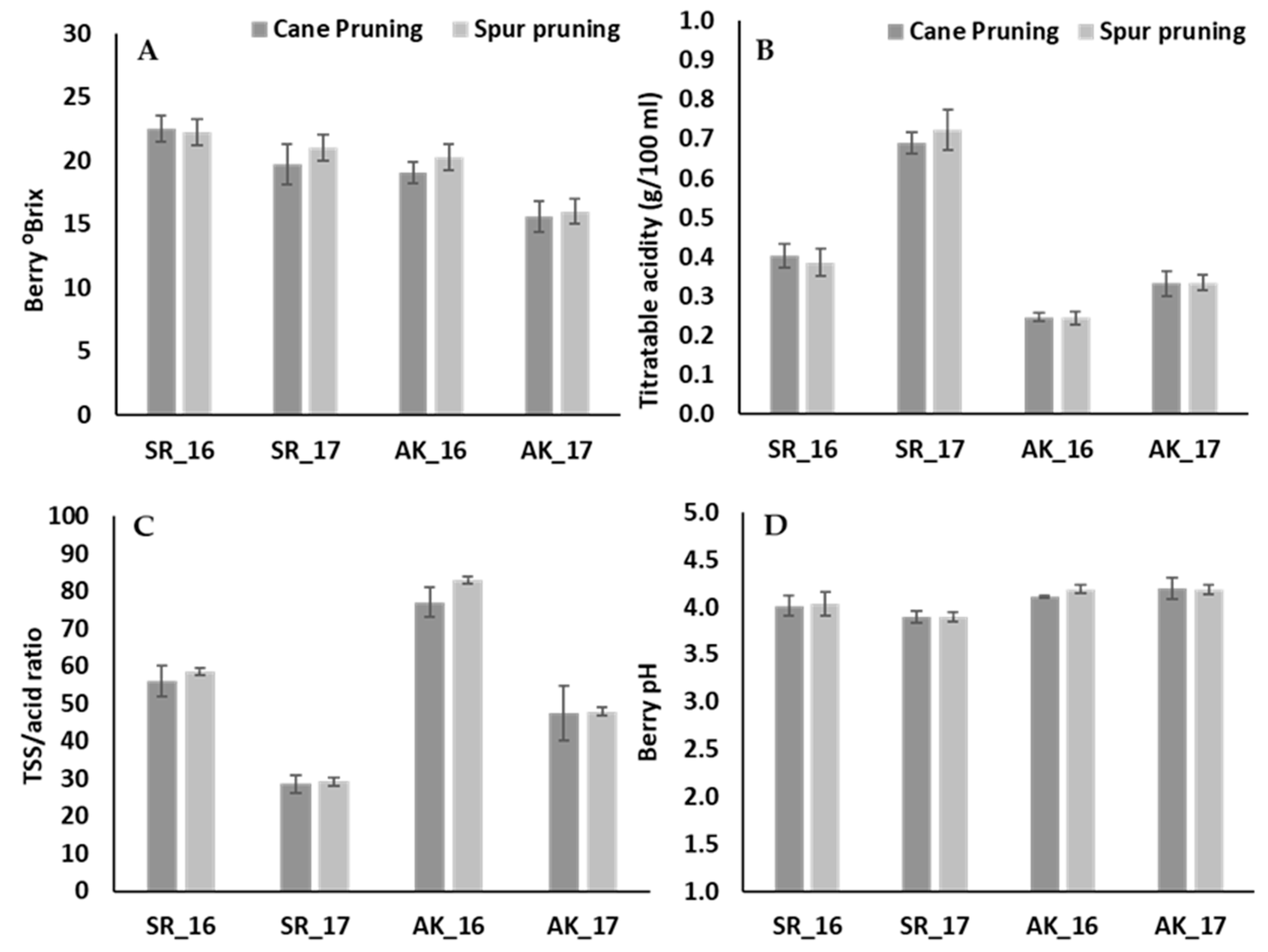Yield and Physiological Response of Autumn King and Scarlet Royal Table Grapes to Cane and Spur Pruning Systems
Abstract
:1. Introduction
2. Materials and Methods
2.1. Site Establishment and Pruning Systems
2.2. Vine Vigor, Canopy Development, and Photosynthetic Activity
2.3. Petiole Nutrient Analysis
2.4. Yield and Berry Compositional Analysis
2.5. Experimental Design and Statistical Analysis
3. Results
3.1. Vine Vigor, Canopy Development, and Photosynthetic Activity
3.2. Bud Fruitfulness, Yield, and Berry Composition Analysis
Bloom Petioles Nutrients Content
4. Discussion
5. Conclusions
Author Contributions
Funding
Institutional Review Board Statement
Informed Consent Statement
Data Availability Statement
Conflicts of Interest
References
- Hashim-Buckley, J. Cultural Practices for Autumn King. University of California Agricultural and Natural Resources. Available online: https://ucanr.edu/sites/Kern22/files/98665.pdf (accessed on 1 July 2015).
- Hashim-Buckey, J.; Ramming, D. Cultural Practices for Scarlet Royal. University of California Cooperative Extension Kern County Newsletter. Available online: https://cekern.ucanr.edu/newsletters/May-June_200835435.pdf (accessed on 1 July 2015).
- Reynolds, A.G.; Wardle, D.A. Evaluation of minimal pruning upon vine performance and berry composition of chancellor. Am. J. Enol. Vitic. 2001, 52, 45–48. [Google Scholar]
- Wessner, L.F.; Kurtural, S.K. Pruning systems and canopy management practice interact on the yield and fruit composition of Syrah. Am. J. Enol. Vitic. 2013, 64, 134–138. [Google Scholar] [CrossRef]
- Howell, G.S.; Mansfield, T.K.; Wolpert, J.A. Influence of training system, pruning severity, and thinning on yield, vine size, and fruit quality of Vidal blanc grapevines. Am. J. Enol. Vitic. 1987, 38, 105–112. [Google Scholar]
- Rosner, N.; Cook, J.A. Effects of Differential Pruning on Cabernet Sauvignon. Am. J. Enol. Vitic. 1983, 34, 243–248. [Google Scholar]
- Peppi, M.C.; Kania, E. Effects of spur or cane pruning on fruit composition of “Cabernet Sauvignon” grapes. Acta Hortic. 2017, 1157, 17–20. [Google Scholar] [CrossRef]
- Eltom, M.; Winefield, C.S.; Trought, M.C.T. Effect of pruning system, cane size and season on inflorescence primordia initiation and inflorescence architecture of Vitis vinifera L. Sauvignon Blanc. Aust. J. Grape Wine Res. 2014, 20, 459–464. [Google Scholar] [CrossRef]
- Bruez, E.; Cholet, C.; Giudici, M.; Simonit, M.; Martignon, T.; Boisseau, M.; Weingartner, S.; Poitou, X.; Rey, P.; Geny-Denis, L. Pruning Quality Effects on Desiccation Cone Installation and Wood Necrotization in Three Grapevine Cultivars in France. Horticulturae 2022, 8, 681. [Google Scholar] [CrossRef]
- May, P.; Clingeleffer, P.R.; Brien, C.J. Pruning of Sultana vines to long spurs. Am. J. Enol. Vitic. 1982, 33, 214–221. [Google Scholar]
- Kasimatis, A.N.; Bowers, K.W.; Vilas, E.P. Conversion of Cane-Pruned Cabernet Sauvignon Vines to Bilateral Cordon Training and a Comparison of Cane and Spur Pruning. Am. J. Enol. Vitic. 1985, 36, 240–244. Available online: http://www.ajevonline.org/content/36/3/240.abstract (accessed on 21 January 2021).
- Badr, G.; Hoffman, J.S.; Bates, T.R. Effect of cane length on concord and niagara grapevines. Am. J. Enol. Vitic. 2018, 69, 386–393. [Google Scholar] [CrossRef]
- Kurtural, S.K.; Dami, I.E.; Taylor, B.H. Effects of pruning and cluster thinning on yield and fruit composition of “chambourcin” grapevines. Horttech 2006, 16, 233–240. [Google Scholar] [CrossRef]
- Senthilkumar, S.; Vijayakumar, R.; Soorianathasundaram, K.; Durga Devi, D. Effect of Pruning Severity on V egetative, Physiological, Yield and Quality Attributes in Grape (Vitis vinifera L.): A Review. Curr. Agric. Res. J. 2015, 3, 42–54. [Google Scholar] [CrossRef]
- Mirás-Avalos, J.M.; Buesa, I.; Llacer, E.; Jiménez-Bello, M.A.; Risco, D.; Castel, J.R.; Intrigliolo, D.S. Water versus source-sink relationships in a semiarid Tempranillo vineyard: Vine performance and fruit composition. Am. J. Enol. Vitic. 2017, 68, 11–22. [Google Scholar] [CrossRef]
- Reynolds, A.G.; Vanden Heuvel, J. Influence of grapevine training systems on vine growth and fruit composition: A review. Am. J. Enol. Vitic. 2009, 60, 251–268. [Google Scholar]
- Ferree, D.; Steiner, T.; Gallander, J.; Scurlock, D.; Johns, G.; Riesen, R. Performance of ‘Seyval Blanc’ grape in four training systems over five years. HortScience 2002, 37, 1023–1027. [Google Scholar] [CrossRef]
- Reynolds, A.G.; Wardle, D.A.; Naylor, A.P. Impact of training systems and vine spacing on vine performance and berry composition of Chancellor. Am. J. Enol. Vitic. 1995, 46, 88–97. [Google Scholar]
- Bernizzoni, F.; Civardi, S.; Van Zeller, M.; Gatti, M.; Poni, S. Shoot thinning effects on whole season photosynthesis and vine performance in Vitis vinifera L. cv. Barbera. Aust. J. Grape Wine Res. 2011, 17, 351–357. [Google Scholar] [CrossRef]
- Li-Mallet, A.; Rabot, A.; Geny, L. Factors controlling inflorescence primordia formation of grapevine: Their role in latent bud fruitfulness? A review. Botany 2016, 94, 147–163. [Google Scholar] [CrossRef]
- Vasconcelos, M.C.; Greven, M.; Winefield, C.S.; Trought, M.C.T.; Victoria, R. The Flowering Process of Vitis vinifera: A Review. Am. J. Enol. Vitic. 2009, 60, 411–434. [Google Scholar]
- Winkler, A.J.; Cook, J.A.; Kliewer, W.M.; Lider, L.A. General Viticulture; University of California Press: Berkeley, CA, USA, 1974. [Google Scholar]
- Diagnosis and Improvement of Saline and Alkali Soils; Handbook No. 60; USDA: Riverside, CA, USA, 1954; pp. 127–135. Available online: https://www.ars.usda.gov/pacific-west-area/riverside-ca/agricultural-water-efficiency-and-salinity-research-unit/docs/publications/handbook-no-60/ (accessed on 1 July 2022).
- Ramming, D.W.; Tarailo, R.E. Grapevine Denominated (Autumn King). U.S. Patent 16284P2, 2006. Available online: https://patents.google.com/patent/USPP16284P2/en (accessed on 1 January 2015).
- Hopping, M.E. Effect of light intensity during cane development on subsequent bud break and yield of ‘Palomino’ grape vines. N. Z. J. Exp. Agric. 1977, 5, 287–290. [Google Scholar] [CrossRef]
- Guilpart, N.; Metay, A.; Gary, C. Grapevine bud fertility and number of berries per bunch are determined by water and nitrogen stress around flowering in the previous year. Eur. J. Agron. 2014, 54, 9–20. [Google Scholar] [CrossRef]
- Clingeleffer, P.R. Plant management research: Status and what it can offer to address challenges and limitations. Aust. J. Grape Wine Res. 2010, 16, 25–32. [Google Scholar] [CrossRef]




| Year-Month | Avg Sol Rad (W/sq.m) | Avg Vap Pres (kPa) | Avg Max Air Temp (C) | Avg Min Air Temp (C) | Avg Air Temp (C) | Avg Max Rel Hum (%) | Avg Min Rel Hum (%) | Avg Rel Hum (%) | Avg Dew Point (C) | Avg Wind Speed (m/s) | Avg Soil Temp (C) |
|---|---|---|---|---|---|---|---|---|---|---|---|
| 16-Jan. | 69 | 1 | 14.4 | 5.1 | 9.3 | 96 | 65 | 85 | 6.9 | 1.4 | 10.1 |
| 16-Feb. | 153 | 1.1 | 20.1 | 4.9 | 11.9 | 96 | 47 | 75 | 7.6 | 1.2 | 12.8 |
| 16-Mar. | 192 | 1.2 | 20.7 | 7.7 | 14.2 | 94 | 45 | 71 | 8.8 | 1.8 | 16.1 |
| 16-Apr. | 254 | 1.2 | 25.2 | 10.4 | 17.5 | 89 | 31 | 58 | 8.8 | 1.9 | 19.6 |
| 16-May | 302 | 1.2 | 28.6 | 13.4 | 21.2 | 85 | 27 | 50 | 9.9 | 1.8 | 22.9 |
| 16-Jun. | 333 | 1.3 | 34.9 | 16.1 | 25.8 | 75 | 17 | 38 | 10.5 | 1.8 | 25.4 |
| 16-Jul. | 336 | 1.4 | 36.7 | 17 | 27.4 | 77 | 17 | 38 | 11.7 | 1.7 | 26.4 |
| 16-Aug. | 298 | 1.4 | 35.9 | 16.1 | 26.1 | 83 | 18 | 42 | 11.9 | 1.4 | 26 |
| 16-Sep. | 245 | 1.2 | 32.3 | 12.9 | 22.3 | 82 | 20 | 45 | 9.7 | 1.3 | 23.1 |
| 16-Oct. | 165 | 1.2 | 25.8 | 9.7 | 17.4 | 88 | 33 | 60 | 9.5 | 1.3 | 19.1 |
| 16-Nov. | 106 | 1.1 | 20.8 | 5.8 | 12.5 | 95 | 46 | 76 | 8.2 | 1 | 15.5 |
| 16-Dec. | 75 | 0.9 | 13.7 | 3 | 7.8 | 96 | 63 | 85 | 5.4 | 1.2 | 10.8 |
| 17-Jan. | 72 | 1 | 13.3 | 4.3 | 8.7 | 95 | 65 | 84 | 6.1 | 1.4 | 10.2 |
| 17-Feb. | 109 | 1.1 | 16.8 | 7.3 | 11.8 | 94 | 59 | 78 | 8.1 | 1.6 | 12.7 |
| 17-Mar. | 194 | 1.1 | 21.4 | 7.1 | 14 | 94 | 41 | 69 | 8.2 | 1.6 | 15 |
| 17-Apr. | 240 | 1.1 | 23.4 | 9.1 | 16.1 | 90 | 31 | 58 | 7.7 | 2.3 | 17.2 |
| 17-May | 295 | 1.2 | 28.3 | 13 | 20.9 | 82 | 27 | 48 | 9.4 | 2.1 | 21.6 |
| 17-Jun. | 319 | 1.5 | 34 | 17.2 | 26 | 77 | 22 | 43 | 12.1 | 2.1 | 24.4 |
| 17-Jul. | 274 | 1.5 | 37.3 | 18.6 | 28.1 | 77 | 19 | 40 | 13.2 | 1.8 | 27 |
| 17-Aug. | 227 | 1.7 | 36.2 | 19.1 | 27.6 | 80 | 24 | 45 | 14.6 | 1.7 | 27.9 |
| 17-Sep. | 214 | 1.5 | 31.4 | 15 | 23 | 83 | 26 | 50 | 12 | 1.7 | 24.9 |
| 17-Oct. | 174 | 1 | 26.4 | 7.9 | 16.4 | 87 | 26 | 55 | 7.2 | 1.3 | 19.7 |
| 17-Nov. | 108 | 1.1 | 20.4 | 6.7 | 12.9 | 91 | 45 | 73 | 7.7 | 1.4 | 16.1 |
| 17-Dec. | 95 | 0.7 | 16.4 | 0.1 | 7.1 | 91 | 38 | 67 | 1.4 | 1.1 | 9.9 |
| 2016 | ||||||||||||
|---|---|---|---|---|---|---|---|---|---|---|---|---|
| Month | Jan. | Feb. | Mar. | Apr. | May | June | July | Aug. | Sept. | Oct. | Nov. | Dec. |
| Total ETo (mm) | 24.09 | 61.88 | 93.46 | 137.94 | 180.52 | 213.47 | 222.52 | 193.92 | 144.1 | 87.45 | 45.17 | 24.42 |
| Total Precip (mm) | 87.5 | 3.2 | 57.9 | 18 | 14.9 | 0.1 | 0.2 | 0 | 0 | 20.9 | 11.7 | 64 |
| 2017 | ||||||||||||
| Month | Jan. | Feb. | Mar. | Apr. | May | June | July | Aug. | Sept. | Oct. | Nov. | Dec. |
| Total ETo (mm) | 24.69 | 39.25 | 94.22 | 130.22 | 179.1 | 204.93 | 201.25 | 165.42 | 132.75 | 94.67 | 49.06 | 39.36 |
| Total Precip (mm) | 122.3 | 58 | 32.2 | 26.9 | 3.8 | 0 | 0 | 0.2 | 5.2 | 1.7 | 9.3 | 1.2 |
| Scarlet Royal | Autumn King | |||||||
|---|---|---|---|---|---|---|---|---|
| 2016 | 2017 | 2016 | 2017 | |||||
| Cane | Spur | Cane | Spur | Cane | Spur | Cane | Spur | |
| NO3-N (mg/kg) | 415.3 * | 262.8 | 2463 | 2220 | 386.8 | 270.0 | 3606 | 3518 |
| P (%) | 0.17 | 0.15 | 0.28 | 0.25 | 0.14 | 0.13 | 0.35 | 0.35 |
| K (%) | 0.73 | 0.62 | 2.28 | 2.16 | 0.64 | 0.57 | 2.04 | 1.89 |
| Zn (mg/kg) | 35.8 | 31.8 | 31.5 | 24.25 | 19.0 | 29.0 | 33 | 41.5 |
| Mn (mg/kg) | 51.0 | 51.3 | 46.8 | 44.3 | 47.5 | 53.8 | 51.7 | 49.5 |
| Na (%) | 0.018 | 0.015 | 0.013 | 0.010 | 0.020 | 0.02 | 0.013 | 0.010 |
| B (mg/kg) | 34.3 | 32.3 | 37.8 | 37.8 | 36.8 | 30.5 | 41.0 | 39.5 |
| Ca (%) | 1.70 | 1.58 | 1.38 | 1.32 | 1.58 | 1.56 | 1.36 * | 1.24 |
| Mg (%) | 0.85 | 0.85 | 0.32 | 0.33 | 0.82 | 0.85 | 0.46 * | 0.38 |
| Fe (mg/kg) | 44.0 | 43 | 57.3 * | 32.8 | 45.8 | 53.8 | 57.7 * | 39.5 |
| Cu (mg/kg) | 3.75 | 4.25 | 8.00 | 7.25 | 6.50 | 4.5 | 6.00 | 5.8 |
| Cl (%) | 0.18 | 0.20 | 0.10 | 0.10 | 0.20 | 0.20 | 0.13 | 0.10 |
Publisher’s Note: MDPI stays neutral with regard to jurisdictional claims in published maps and institutional affiliations. |
© 2022 by the authors. Licensee MDPI, Basel, Switzerland. This article is an open access article distributed under the terms and conditions of the Creative Commons Attribution (CC BY) license (https://creativecommons.org/licenses/by/4.0/).
Share and Cite
El-kereamy, A.; Kurtural, S.K. Yield and Physiological Response of Autumn King and Scarlet Royal Table Grapes to Cane and Spur Pruning Systems. Horticulturae 2022, 8, 802. https://doi.org/10.3390/horticulturae8090802
El-kereamy A, Kurtural SK. Yield and Physiological Response of Autumn King and Scarlet Royal Table Grapes to Cane and Spur Pruning Systems. Horticulturae. 2022; 8(9):802. https://doi.org/10.3390/horticulturae8090802
Chicago/Turabian StyleEl-kereamy, Ashraf, and Sahap Kaan Kurtural. 2022. "Yield and Physiological Response of Autumn King and Scarlet Royal Table Grapes to Cane and Spur Pruning Systems" Horticulturae 8, no. 9: 802. https://doi.org/10.3390/horticulturae8090802
APA StyleEl-kereamy, A., & Kurtural, S. K. (2022). Yield and Physiological Response of Autumn King and Scarlet Royal Table Grapes to Cane and Spur Pruning Systems. Horticulturae, 8(9), 802. https://doi.org/10.3390/horticulturae8090802







